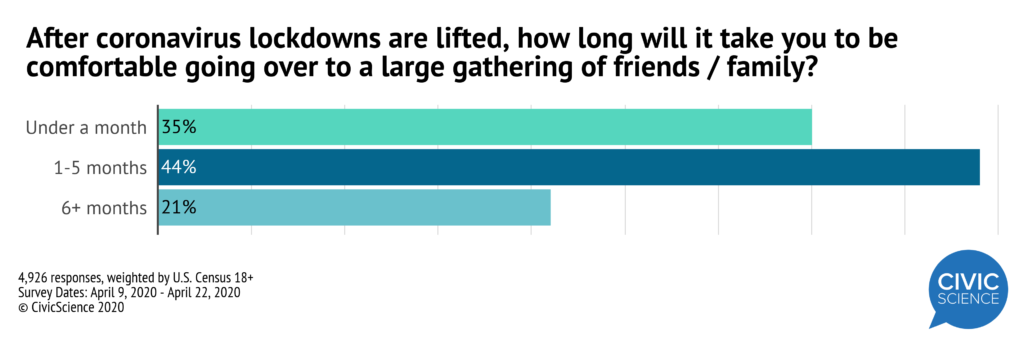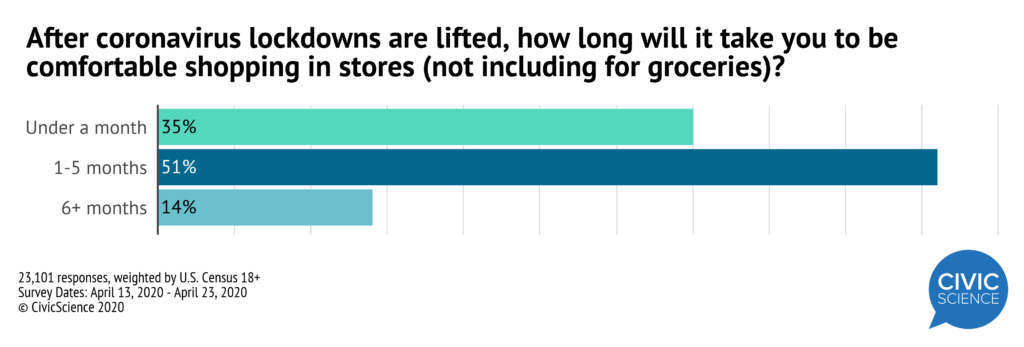As weeks wear on and the current reality becomes considerably more difficult for millions of Americans, it’s tempting to imagine what the other side of lockdown might look like. It’s nearly impossible to guess when that will arrive. All that seems clear for now is that there won’t be a clean cleave between the period we’re currently living in and whatever comes next.
In a recent CivicScience study, data revealed varying levels of comfort going back to certain activities, whether social, commercial, or for entertainment.
Americans will undoubtedly ease back into activities as stay-at-home orders are lifted, with certain social activities taking precedence in the beginning. Everyone has a different set of priorities, but close to half of adults will be ready to attend small get-togethers with family and friends within one month of lockdowns being lifted.
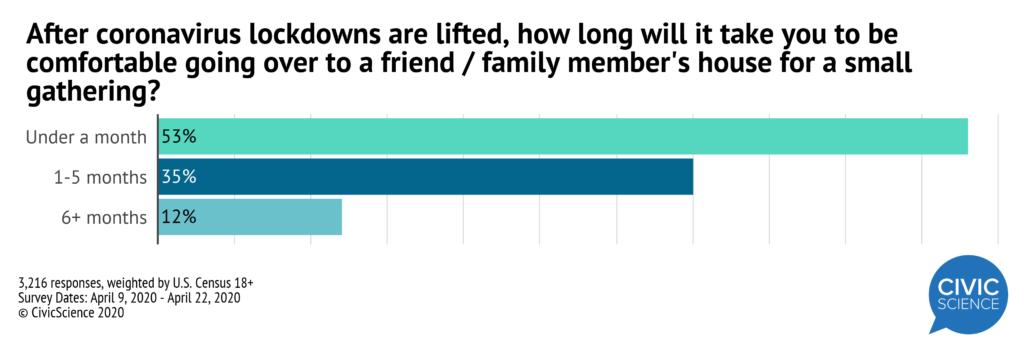 However, the time frame in which people were willing to gather in small groups of friends or family again was different for people making under $50K a year. Those with a household income under $50K were less likely to say they would gather again in less than a month. They showed higher instances of wanting to wait 6 months or more.
However, the time frame in which people were willing to gather in small groups of friends or family again was different for people making under $50K a year. Those with a household income under $50K were less likely to say they would gather again in less than a month. They showed higher instances of wanting to wait 6 months or more.
Large friend and family gatherings — presumably something like a party, family reunion, or wedding — also stand to be some of the earliest social events back on the calendar. Thirty-five percent of adults would be ready for large gatherings in under a month but the majority say that waiting for a longer period of time would make them most comfortable.
Restaurants and Eating Out
Restaurants, which in some cases have been operating through the pandemic as takeout-only with modified menus, poll similarly to large family gatherings.
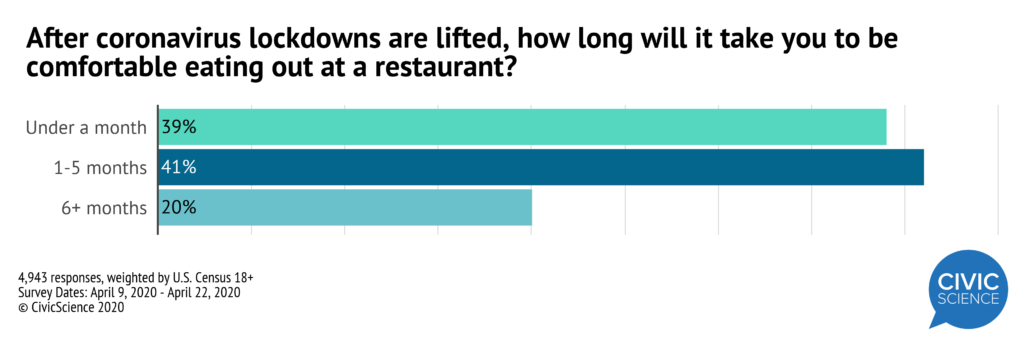 There are some stark differences across gender lines, with 23% more adult men than women feeling comfortable to return to restaurants within one month. And much like with family gatherings, higher earners tend to favor a quicker return to restaurants after distancing guidelines are relaxed.
There are some stark differences across gender lines, with 23% more adult men than women feeling comfortable to return to restaurants within one month. And much like with family gatherings, higher earners tend to favor a quicker return to restaurants after distancing guidelines are relaxed.
In-Store Shopping
Not including trips to grocery stores, 35% of U.S. adults said they would return to in-store shopping within less than a month of lockdowns being lifted. Unsurprisingly, these individuals tended to be younger, make a higher salary, and are more likely to be male.
Movie Theaters
As nearly every major studio has cleared its calendar of summer movie releases — Mulan on July 24 will be among the first — it presents a challenge for movie theaters going forward. When will people be ready to pack into a dark theater with a hundred other moviegoers? It could be a while. According to a recent CivicScience study of 4,000 adults, 25% surveyed won’t feel comfortable returning to the movies for 6 months or more after lockdowns are lifted. That certainly backs up the decision for many major releases to move into the winter, or even next year.
Even more so than with other public gatherings and in-store shopping, an eagerness to return to the movies skews younger, with 41% of 18- to 24-year olds comfortable returning within a month. Hesitance significantly increases among older moviegoers, with 47% of those 55 or older saying they would wait more 6 months or more to return to the big screen.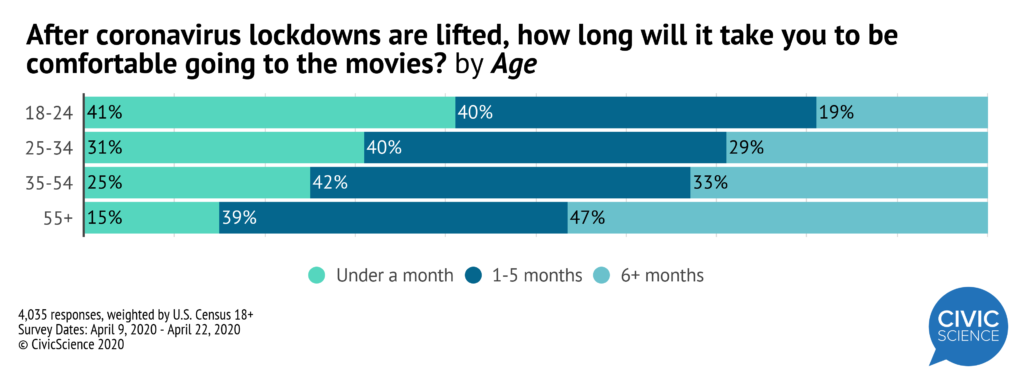
Similar to restaurants that will gradually re-open, we’re likely to see some sort of protracted return for movie theaters, whether it means reduced capacity or showing old movies before any new releases arrive. All technically non-essential entertainment outlets will face this same barrier, as consumers may opt for trips out to eat or visiting friends before taking a chance on the movies.
Concerts, Sports Games, Large-Scale Events
Los Angeles and New York mayors, along with health experts, have already advised that concerts, sporting events, and other large gatherings on that scale may not be feasible until 2021, possibly earlier if a vaccine becomes available. Like with easing into socializing, large-scale events could also gradually begin with small venues and clubs, or limited capacity at sporting events before anything resembling the previous crowd sizes can gather. CivicScience data indicates that consumers are much more tentative about resuming these sorts of events, with 38% of adults saying it would take 6 months or more before they were ready. 
Younger consumers tend to show less trepidation about returning to events with large crowds. A majority of respondents who’d feel comfortable returning within 1 month after lockdowns are lifted are between the ages of 18 and 34. And like with returning to restaurants, women are slightly more hesitant than men about returning to large public events.
Emerging from quarantine will certainly be a phased process. The first priority among the majority of Americans is getting back together with family and friends in small groups. Outside of small social engagements, the timetable for public activities feels much more remote. While those showing more readiness to get back to normal activities were usually younger, male, or earning over $50K a year, it’s hard to imagine something like a sporting event or concert happening until this fall at the earliest, and even that might be too optimistic.
